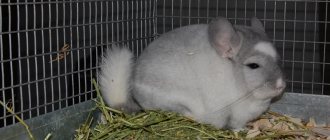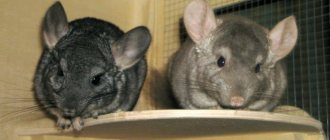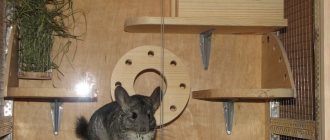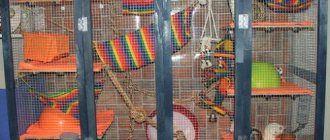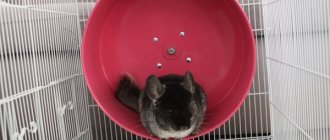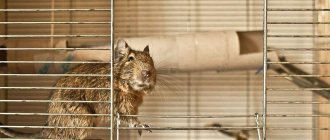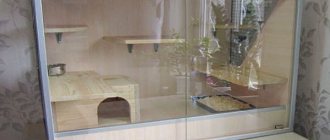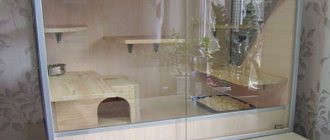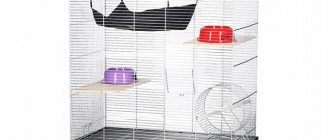A chinchilla cage in a pet store is quite expensive for you to think about making it yourself. And finding a product that is suitable in all respects is quite difficult. By working on your own, you can not only save a lot of money, but also make an enclosure that is significantly superior in functionality to factory-made analogues. First you need to figure out what kind of cage is needed for a chinchilla, and then decide on the materials and its internal contents.
Features of a chinchilla cage
On sale you can find various options for cages and specialized display cases for chinchillas. They all have a number of differences between themselves.
Dimensions
A chinchilla cannot be called a calm animal, so in order for the animal to be active, it is necessary to choose the right cage size . There should be enough space for the animal to run and jump freely. The minimum cage sizes for keeping different numbers of animals will be as follows:
- for one chinchilla - 80x65x50 cm;
- for a pair of chinchillas - 90x90x50 cm;
- several animals - 100x70x50 cm.
If several chinchillas are kept, then composite structures are created for the animals. This allows the animals to be seated at the right time.
Materials
Galvanized mesh and metal are used in the production of cages. Trays in cages and additional accessories (drinkers, feeders) are made of plastic, as it is less susceptible to moisture. Various protruding parts should be avoided, as the animal can gnaw them, and this often becomes the cause of various diseases.
IMPORTANT! There should be no painted or varnished parts in the chinchilla's house.
Shelves made of plastic with metal edging are very convenient to use, they are easy to clean and last a long time. But if the plastic is slippery and smooth, then the animal may get injured. It is better to give preference to rough surfaces made of natural materials.
It is also worth paying attention to the bars in the cage. The distance between them should not be more than 2.5 cm, otherwise the chinchilla may damage its paws while moving around the cage. For females with offspring, this distance should be even smaller - 1.5 cm. The rods should not be too thin, the permissible width is 1.5 mm.
In addition to cages, chinchilla owners often choose special display cases as a home for the animal. They are made of wood and plexiglass. Such materials are safer for chinchillas, but caring for them poses a number of difficulties.
Wood, unlike plastic and metal, quickly absorbs odors and cannot be disinfected. However, chinchillas are very fond of wooden houses; they can sharpen their teeth on wood.
IMPORTANT! The display case cannot be made from coniferous trees.
Many modern display cases for chinchillas are made of plexiglass with an aluminum frame. For such houses, sheets of plexiglass with a width of 6 mm or more are used; the edges must be processed so that the animal does not get hurt.
Cells can be disassembled or intact
Design
By design, chinchilla cages can be dismountable or solid. The main advantages of collapsible cages are as follows:
- they are easy to transport;
- convenient to store;
- just carry out disinfection.
The main disadvantage is that all the constituent elements of the cage are not tightly fixed to each other, unlike a solid structure. Because of this, a loud noise is heard when the chinchilla is active.
Many models are equipped with a retractable tray, which makes cleaning much easier. Often such pallets are covered on top with a second mesh bottom. The garbage immediately passes through the mesh and ends up in the tray, but the animal can get its paws stuck in such a mesh and get injured trying to get out of it.
Cages equipped with wheels are very convenient to use. Debris regularly appears around the cage and cleaning will require constant moving of the cage. It is much more convenient to do this on wheels, but you need to take care of the stability of the structure.
Showcases take up more space than cages, but have good sound insulation.
IMPORTANT! When purchasing a display case or having it custom-made, you need to ensure there is good ventilation and easy access to the inside for cleaning.
Which house is better?
Dimensions for keeping animals for breeding purposes
When keeping rodents for the purpose of breeding, structures made of blocks for females are installed. The sections are connected by corridors so that the male can move along them. This design has a significant disadvantage - females will have to purchase collars. The minimum cage size for a chinchilla is 500x400x400 mm.
It is possible to keep a family of chinchillas consisting of 1 male and 4-8 females in one spacious section. The cage dimensions are calculated based on the minimum size for one animal.
Which “home” is better for a chinchilla – a cage or a display case?
It doesn’t matter much to the animal whether the walls of the home are made of wire or solid. The main thing is sufficient space and safety.
When choosing a house, you also need to take into account the conditions in the apartment or house itself. So, you should give preference to a showcase if:
- there is enough space for its installation;
- the windows or doors in the room are poorly insulated, and therefore there are drafts;
- there are other animals in the house that do not live in cages;
- people with allergies or small children will live with the chinchilla;
- no plans to move.
If a chinchilla is purchased for breeding and the number of animals will increase in the future, then it is better to purchase a set of cages. They can be combined and, if necessary, installed separately from each other.
Parameters for two or more animals
For two chinchillas you need a home with dimensions of at least 900x900x500 mm. To calculate the size of a cage for several rodents, the minimum size of 700x700x500 mm is multiplied by the number of animals. An excellent solution is a multi-tiered credo cage.
To make the animals comfortable during the warm season, an enclosure is placed on the balcony or in the yard. The size of such a fence is unlimited. Enclosures are frames covered with metal mesh. If the structure is placed on the street, a metal sheet must be placed at the bottom and the walls are sheathed with iron to a height of 500 mm. This will protect against the appearance of field mice and other wild animals in the enclosure, and at the same time serve as shelter from the winds. Sawdust is used as filler.
Enclosures are installed under a canopy or have a roof to protect them from rain. Such structures help out when it is not possible to place a spacious cage in the house for a family of chinchillas.
How much does a chinchilla cage cost?
The price of the cage depends on the quality of materials used, size and configuration. Of course, the cost also depends on the manufacturer. Products from popular brands will cost more. Thus, the price of budget options starts from 3,000 rubles, more comfortable and equipped housing for a chinchilla costs an average of about 7,500 rubles, and spacious options from popular brands will cost an average of 12,000 rubles.
Below is a table of commercially available chinchilla cages.
| Brand name | Cell characteristics | Price |
| Ferplast | The Ferplast Cincilla Kd cage is equipped with plastic shelves, a drinking bowl, a feeder and a house. Dimensions 80x50x80 cm. | From 16,500 rub. The price for large cages starts from 22,000 rubles |
| For | Fedro Natura cage. The set includes ladders and shelves made of wood, as well as a drinking bowl and feeder. Size 66x45x76 cm. | Price 6500 rub. A similar model with a height of 121 cm costs 13,500 rubles. |
| Credo | Two-door model made of thick plastic and galvanized mesh. Equipped with shelves and ladder. Size 64x44x93 cm. | Price 6500-7500 rub. |
| Triol | The model with parameters 61x46x45 cm is equipped with two doors. There is 1 plastic shelf inside. | Price from 3,900 rub. |
Have you decided to buy a ready-made cage or will you make it yourself?
DIY chinchilla cage at home
It is not at all necessary to buy a ready-made house for a chinchilla. You can build it yourself, which will not require large financial costs.
Materials and tools
For manufacturing you will need the following materials:
- steel mesh with a small gap between the rods;
- metal tubes or corners;
- metal sheet for making the bottom;
- hinges and several locks;
- screws, screws, nuts;
- hacksaw for metal (grinder, if available);
- welding machine.
You will also need a drawing of the future house. You can use options from the Internet, where experienced chinchilla breeders share their work, or you can prepare your own project.
Instructions for making a chinchilla cage at home with your own hands
So, step-by-step instructions for making a cage for a chinchilla will be as follows:
- Assembling the cell frame. To do this, you need to cut the metal tubes to the required size and fasten them together using angles and screws.
- A metal bottom is welded to the bottom of the frame. Boards or a sheet of plywood are laid on top of the metal sheet.
- Sheets are cut out of the mesh in a size corresponding to the size of the frame, and then attached to the tubes also using angles and screws.
- A roof is installed on top of the cage walls. It needs to be removable so that you can easily access the inside for cleaning. To make the roof you will need a metal frame and mesh. It is better to use special hinges with a lock as a lock.
IMPORTANT! The bottom of the cage cannot be made only of wood, as the chinchilla can over time completely gnaw through it and run away. It is impossible to leave metal alone because of the appearance of rust on it from moisture.
The house should have a lot of accessories
Housing dimensions for one rodent
The chinchilla should have a large cage in which it can move freely. For one rodent, the minimum cage dimensions are 700x700x500 mm. It’s even better if the home has a size of 900x500x400 mm.
Chinchillas lead an active lifestyle; they need space to walk and play. Experienced breeders do not recommend limiting the animal to minimum dimensions. The design should include a retractable tray to maintain cleanliness. The base can be made of wood or durable plastic, but the grill itself is metal.
The safe distance between the rods is no more than 20 mm.
Whatever housing shape and material is chosen, it must be well ventilated, otherwise the animal will get sick and the fur will begin to peel.
What should be in a chinchilla's cage?
One cage is not enough for the animal to live comfortably. The house needs to be equipped with various accessories.
Drinking bowl
The animal must always have access to clean water. A drinking bowl must be placed in the house. It is better to attach it to the wall or door of the cage. There is no need to place it on the floor, as a chinchilla can easily turn it over and there will always be debris in the water. Drinkers can be nipple or ball, you can choose according to the animal’s preference, the main thing is that it does not leak.
Feeder
Feeders are usually made of plastic. It is better to choose a deeper option, but the animal should be comfortable using it. Like the drinking bowl, it is better to attach the feeder to the wall of the house so that all the contents do not end up on the floor. The feeder must be washed regularly.
Sennitsa
You should definitely include hay in your chinchilla's diet. To prevent it from being scattered throughout the cage, it can be placed in a special feeder. Pet stores sell these for chinchillas, but in practice they are not very convenient. It is better to purchase a closed running ring for hamsters for this, but it will also need to be secured in the cage.
Cabin or hammock
If the size of the cage allows, then a special house should be built for the chinchilla; hammocks are very common. If the cage is small or the animal does not like to rest in the house, then it should have special shelves where it can fit. You should choose options with a width of at least 15 cm, since chinchillas rest stretched out to their full height.
Mineral stone
To prevent the chinchilla from sharpening its teeth on the wooden elements of the cage, you should purchase a special mineral stone. It must be installed in full view of the animal, attached to the cage.
Bathing suit
The animals bathe in a non-standard way; they do it in the sand. Therefore, there should be a small container with sand in the house. It should be comfortable for the animal to roll over in it, and to prevent it from knocking it over, the bath should be secured.
Toilet
To maintain cleanliness in the cage, you should install a tray for the animal. Chinchillas are very clean, so there will be no problems using it.
Game Zone
Chinchillas lead a very active lifestyle and are very playful. If the size of the house allows, you need to place more different toys so that the animal does not get bored.
Stairs and suspension bridges
Climbing ladders and bridges do not have to be purchased; you can make them yourself from branches of different thicknesses. Twigs from willow, birch, poplar, and rowan are best suited. Toys will also be a treat for the animal.
Wheel
It is better to buy a plastic wheel that is attached to the wall of the cage, or make it yourself from wood. Metal ones can easily injure the animal.
Toys
Also in the house you can place small plastic tunnels, hammocks, and swings. The main condition is that all toys must be safe for the animal.
It is not necessary to add filler, but it is highly recommended
Town
Chinchillas are animals prone to obesity, and they need active movement just like food and water. You can make chinchillas move by building them easy-to-climb routes in the “town.”
The town includes:
- running wheel for chinchillas;
- shelves fixed at different levels;
- transitions between shelves.
The variety of transitions is limited only by the imagination and skill of the chinchilla owner.
It can be:
- suspension bridges;
- tunnels;
- stairs;
- swing.
The only requirement for all these products is natural wood without paint or varnish. You can make transitions from unsanded branches of edible tree species. And change it periodically.
The role of a transition, a toy and a place to rest is simultaneously performed by a hammock for a chinchilla suspended in a display case. It is made from dense non-stretch fabric. Denim suits well. They secure it so that the chinchilla can jump into the hammock, but cannot swing it too much.
In addition to shelves and passages, the town must have a running wheel and a treadmill. The wheels are sold in pet stores and are designed for all active small animals. You need to buy a wooden or plastic one, as a metal wheel can be dangerous for a chinchilla. But you can do it yourself.
DIY chinchilla wheel
To make a wheel you will need:
- 2 sheets of plywood with a side of at least 40 cm and a thickness of at least 1 cm;
- up to 10 figured meter slats;
- automobile tension bearing;
- drill;
- drill 12 mm;
- self-tapping screws;
- 2 bolts with a diameter of 12 mm: long and short;
- screwdriver;
- washers for bolts;
- nuts for bolts;
- jigsaw
Manufacturing technology:
- Find the middle in the pieces of plywood and drill holes. Using a jigsaw, cut out 2 circles of 30 cm in diameter.
- One is left, another circle with a diameter of 25–27 cm is cut out of the other. Only a large circle will be needed from this circle.
- The slats are cut into pieces about 15 cm long. The size of the slats depends on the chinchilla. The animal must fit freely into the wheel.
- The cut slats are attached closely to the ends of the circle and the cut out circle.
- Put a washer on the long bolt, insert the bolt from the inside into the wheel, put on another washer and screw the structure with a nut.
- A hole for a bolt is drilled in the wall of the display case.
- The center of the bearing is aligned with the hole in the wall and the bearing is screwed in with self-tapping screws.
- The wheel with the bolt is inserted into the bearing and tightened with a nut from the outside of the display case.
The video shows in sufficient detail how to make a running wheel for chinchillas.
Treadmill
For chinchillas, this is an additional device, and it is easier to buy it in a store. There it can be sold as a treadmill for decorative hedgehogs. She looks like this.
Now the display case contains everything necessary for a happy life for chinchillas. All that remains is to figure out what a walking ball is.
Chinchilla ball
This is a device that a chinchilla should not have. The plastic ball transmits infrared rays very well and heats up from the inside. Chinchillas do not tolerate heat well. Half an hour in such a ball is enough for the animal to die.
In such a ball, some careless owners of small animals let them “walk” in the fresh air and eat the green grass that falls into the cracks of the ball. Juicy food is contraindicated for chinchillas. And the stress of a walk is much more harmful than being in a spacious display case.
Cage Filling Options
It is not necessary to add litter to the cage, but it is advisable. This will allow you to better maintain cleanliness and will not lead to an unpleasant odor. Fillers come in the following types:
- woody;
- straw;
- sawdust;
- corn;
- toilet paper.
It is better to give preference to corn or wood filler; they absorb odors best. To save money, you can use straw or regular toilet paper.
IMPORTANT! It is forbidden to use pine filler, since the resin of pine trees is dangerous to the life of the chinchilla.
Where to put a chinchilla's cage?
Not only the comfort, but also the health of the animal depends on where the cage is installed. So, when choosing a place, you should use the following recommendations:
- there should be no excess moisture in the room;
- the room should be well ventilated, but there should be no drafts;
- the cage should not be placed in direct sunlight;
- chinchillas do not like too high temperatures, so the air temperature in the room should be no higher than 25 degrees;
- there should be no heating devices or air conditioners near the cage;
- It is best to place the chinchilla’s house on a table or bedside table;
- It is not recommended to place the cage next to a computer, TV or other equipment;
- furniture and walls should be no closer than 5 cm from the cage so that the chinchilla does not damage them;
- The animals are active at night, so it is better not to place their house in a room where someone is sleeping.
